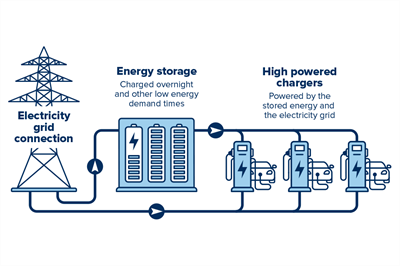The challenge of finding somewhere to rapidly charge electric vehicles (EVs) during a long journey on England’s motorways could become a thing of the past thanks to a multi-million-pound investment from National Highways.
.tmb-small.jpg?sfvrsn=ed855b7a_1) The government-owned organisation plans to invest £11 million in Energy Storage Systems (ESS) - essentially giant battery packs – to support service stations where the grid supply is presently insufficient for rapid charging infrastructure.
The government-owned organisation plans to invest £11 million in Energy Storage Systems (ESS) - essentially giant battery packs – to support service stations where the grid supply is presently insufficient for rapid charging infrastructure.
Around 20 ESS will be installed to temporarily provide power for rapid high-power charging as a means of bridging the gap until motorway services are able to obtain the increased power they need directly from the grid. The work is expected to be completed within the next two years.
The announcement comes following Transport Day at COP26 last November, which focussed on the global transition to zero emission transport, an aim of both the government and National Highways. It’s hoped the move will bring an end to ‘range anxiety’ by improving the network of charge points for EV drivers using England’s motorways and major A-roads.
These rapid chargers are part of the government’s vision for the rapid charge point network in England which set the goal of installing 6,000 high-powered chargers on the motorway network by 2035.
Malcolm Wilkinson, Head of Energy for National Highways said, “We are working differently and innovating to support the switch to zero emission journeys.”
“Whilst we have limited control over the number of petrol and diesel cars on the network, by supporting the expansion of the rapid charge points network, we hope to increase EV drivers’ confidence for all types of journeys, both long and short.”
“These new Energy Storage Systems and the rapid chargers they supply will ensure that motorists are unlikely to be caught without somewhere to charge, which is a fantastic move for drivers and the environment, accelerating the speed in which we transition to new electric vehicles.”
Transport Minister Trudy Harrison added, “Our vision is to have one of the best electric vehicle infrastructure networks in the world and we want charging to be quick and easy for all drivers.”
“This additional investment will ease drivers’ range anxiety as we continue to power up the green revolution.”
Photos (top to bottom):
Electric charging point.
ESS will store electricity for high-power charging on motorways where grid supply is insufficient.